26 French Châteaux You Have to Visit in 2023
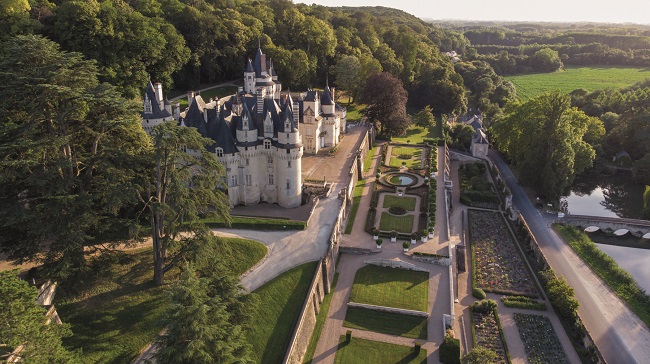
No other country can boast as many well-preserved castles and country houses as France. Step back in time and immerse yourself in beautiful gardens and architecture: from the riverside beauties of the Loire Valley to the fairy tale castles of Alsace to the hilltop forts of the southwest, there are hundreds of châteaux available for visits across France, offering an intriguing glimpse into the life, culture and decadence before the Revolution.
Châteaux to visit
Indulge your love of architecture and interiors as you wander in awe around these beautiful châteaux. And if you’re lucky, a bit of French aristocracy might rub off on you.
Château Royal de Blois, Loir-et-Cher
Architecture from the 13th to the 17th centuries is on display at this fine château in the Loire Valley. There are four distinct wings surrounding a central courtyard: medieval, Gothic (from the reign of Louis XII), early Renaissance and classical 17th century. Steeped in history, the château has witnessed some pretty grisly episodes. The grisliest of all was in the 16th century when King Henri III lured the Duke of Guise into his counsel chamber only to have him stabbed to death by a troop of royal bodyguards. The king himself hid behind a tapestry while the evil deed was carried out. Between April and November, dramatic sound and light shows are put on in the château courtyard.
en.chateaudeblois.fr
Château de Pierrefonds, Oise
First built in the late 14th century by Louis of Orleans, this awe-inspiring castle lay in ruins for much of its existence until Napoleon III commissioned the famous architect Eugène Viollet-le-Duc to restore it to its medieval glory. The result is a vast eight-towered château straight out of a fairy tale, complete with drawbridge, gargoyles and dungeon, all surrounded by the thick Compiègne Forest. Open 9.30am–6pm daily from June 13 to September 4, and 10am–5.30pm from September 5 to April 30.
www.chateau-pierrefonds.fr/en
Château de Compiègne, Oise
Built for King Louis XV and restored by Napoleon, this château, 85km north of Paris, used to be one of the three seats of royal government. Its proximity to the forest and hunting grounds of the same name made it the preferred summer residence of French monarchs for many centuries. There is a huge amount to see here, including the park, the château apartments themselves, the Musée du Second Empire, the Musée de l’Impératrice, and the Musée National de la Voiture, which boasts a superb collection of cars, carriages and bicycles. It’s open most days of the year, with free entry on the first Sunday of the month.
chateaudecompiegne.fr
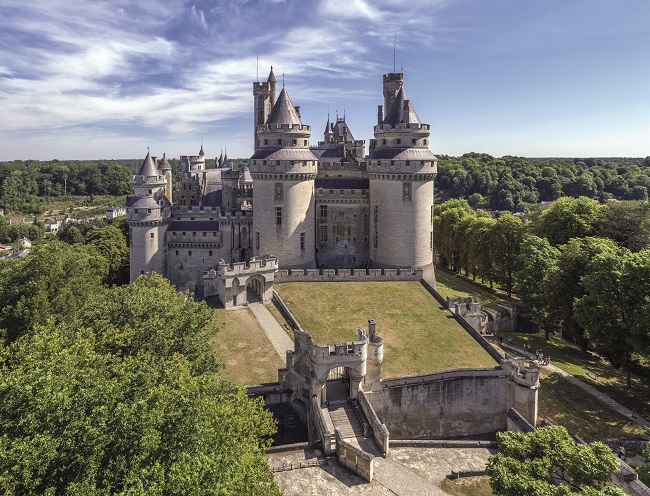
Château de Pierrefonds © © Christian Gluckman / Centre des monuments nationaux
Château de Château-Thierry, Aisne
“A gem of medieval defensive architecture,” is how the local tourism office describes this ancient castle, dating back to the 13th century. There’s falconry, a rose garden with 50 or so different varieties, and the remains of what it claims were “the largest medieval kitchens in Europe”. It’s open all year round and is free to visit.
www.chateau-thierry.fr
Château de Condé-en-Brie, Aisne
“The castle has a real sense of authenticity, with many original paintings and interior features,” say the owners. “Its sparkling history, its bedrooms, its boudoirs and its salons are straight out of a fairy tale – all easily discovered and shared with the whole family.” There’s also a treasure trail in the surrounding parkland. The château is open from April until November. Entry prices start at €12 per person.
www.chateaudeconde.fr
Château d’Amboise, Indre-et-Loire
Sitting atop a rocky outcrop on the southern bank of the Loire, the Château d’Amboise comes alive when you learn of the famous historical characters who once lived (and died) here. In the late 1400s, while on his way to watch a game of real tennis, King Charles VIII bumped his head on a door lintel, fell into a coma and died hours later. More violent was the fate of a band of Protestant conspirators who, in the 1500s, were disembowelled and hanged from the balcony of the château’s Salle des États. Mary, Queen of Scots once lived here too, as did Leonardo da Vinci, whose remains are believed to be buried in the nearby chapel of St Hubert. (Access to the chapel interior is limited.)
www.chateau-amboise.com
Château de Beaugency, Loiret
The highlight of this château in the Loire Valley is its centre dedicated to digital art. For 2023, the central exhibition is an immersive show of Vincent Van Gogh’s famous work, La Nuit Étoilée (Starry Night). “Travel through a luminous, digital universe where medieval and Renaissance architecture is revealed through beams of light and pixilation,” invite the curators. The show takes between an hour and 90 minutes to drink in, and runs throughout the château’s
19 rooms and the adjoining gardens. Open from April to December.
www.chateau-beaugency.com

Château d’Amboise © David Darrault
Château du Haut-Koenigsbourg, Bas-Rhin
Perched on a forested promontory in the Vosges mountains and constructed from bright red sandstone, this Alsatian château stands out for miles around. Although no one is sure when it was built, it’s certain the vast structure was an important outpost during the Middle Ages. By the 1600s it had been abandoned and wasn’t rebuilt until the German Kaiser Wilhelm II took an interest at the beginning of the 20th century. Over the years many film directors have been inspired by the castle, including Jean Renoir (for La Grande Illusion) and Peter Jackson (for The Lord of the Rings). Today it is a major tourist attraction, open all year round, and drawing in half a million visitors a year.
www.haut-koenigsbourg.fr/en
Château de Meung-sur-Loire, Loiret
With original construction dating back to the 12th century, this former castle and episcopal palace in the Loire Valley was captured from the English by Joan of Arc in 1429. Nowadays it makes for a wonderful family day out with attractions and activities such as a mini-farm, historical enactments, a paddock of deer and a dragon’s lair. The château opens for the season on April 8, with tickets priced €12 for adults, €8.50 for childen.
chateau-de-meung.com
Château d’Herouville, Val d’Oise
Elton John, Pink Floyd, Joan Armatrading, T.Rex, Cat Stevens, Iggy Pop, David Bowie, Bee Gees, Fleetwood Mac… this château north of Paris has hosted rock and pop royalty over the years thank to its famous recording studio. Here’s Jerry Garcia, the lead singer of the American band The Grateful Dead, recalling a gig his band played there in the early 1970s: “We played to a handful of townspeople in Auvers. We played and the people came – the chief of police, the fire department, just everybody. It was an event and everybody just had a hell of a time, got drunk, fell in the pool. It was great.”
Contact the château direct for visiting options. And don’t fall in the pool.
www.lechateaudherouville.com
Château de Fougères, Ille-et-Vilaine
One of Europe’s largest châteaux, Fougères has been around in one form or another for 1,000 years or so. Naturally protected by amarsh and the River Nançon, it features a dozen impressive towers, as well as inner courtyards and gardens, all encircled by ramparts – perfect for holding out when under siege by the invading English. For visitors, this Breton château offers an intriguing glimpse into what life was really like in the Middle Ages. Open most of the year, except for January.
chateau-fougeres.com/fr
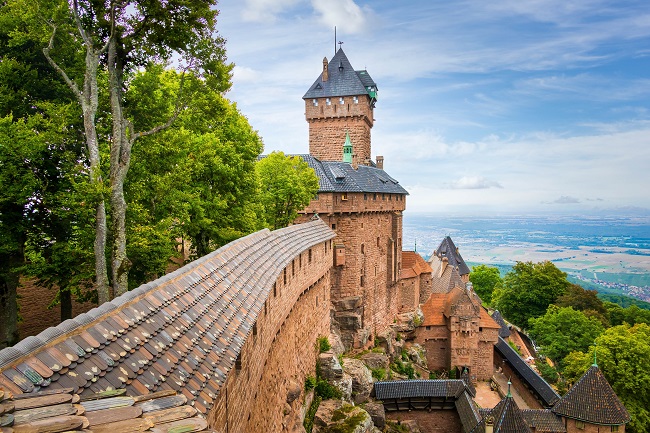
Château du Haut Koenigsbourg © jyanlun / shutterstock
Château de Joux, Doubs
Standing sentry high above the valley, surrounded by jutting cliffs and forests, this brooding fortress in the Jura Mountains looks like a backdrop from The Lord of the Rings. A century in the making, it was built to defend important trade routes through the valley, although it wasn’t always a stronghold. During the 18th and 19th centuries it served as a bleak state prison, its most famous inhabitant the Haitian revolutionary Toussaint Louverture, who died here in 1803, having spent eight months behind bars.
www.chateaudejoux.com
Château de Fontainebleau, Seine-et-Marne
There are no fewer than 1,500 rooms in this opulent château just 34 miles from Paris, most of them adorned with beautiful paintings, tapestries, frescoes, carvings, fireplaces and furniture. At one time even Leonardo da Vinci’s Mona Lisa hung here. The human residents who called it home over the centuries are even more impressive, and include kings, queens, emperors and World War II generals. Beyond the château walls, the 130 hectares of parkland and gardens – partly designed by André Le Nôtre – are suitably resplendent. Open all year round.
www.chateaudefontainebleau.fr/en
Château de la Hunaudaye, Côtes-d’Armor
This medieval fortress sits in a tranquil corner of northern Brittany. As with most castles built in the Middle Ages, it was created to defend – in this case, the eastern border of the Penthièvre territory. Sadly, the château was reduced to rubble in a civil war, before a heroic revival in the late 1300s which saw the introduction of its trademark circular towers. Eventually, at the tail end of the 15th century, it became a symbol of the Tournemine family’s new-found power and status, cementing itself as a prestigious regional landmark. (Open daily from April 1 to September 17; and from October 21 to November 5.)
www.la-hunaudaye.com
Château de l’Islette, Indre-et-Loire
“Through the trees in the distance, I see the tortuous course of the Indre, and an ancient château, flanked by towers,” wrote the playwright Pierre Beaumarchais in 1769 of this château which overlooks the River Indre. Indeed, the first thing you’ll notice is the castle’s captivating beauty: the glowing white limestone, the flower-bedecked walkways, and reflections dancing on the surface of the moat. But there’s more to this leafy Loire Valley oasis than meets the eye, as it also once hosted legendary sculptors Camille Claudel and Auguste Rodin, who conducted their tempestuous love affair here in the late 1800s. Open every day from May 1 to September 30, and all year round for groups with reservations.
www.chateaudelislette.fr/en
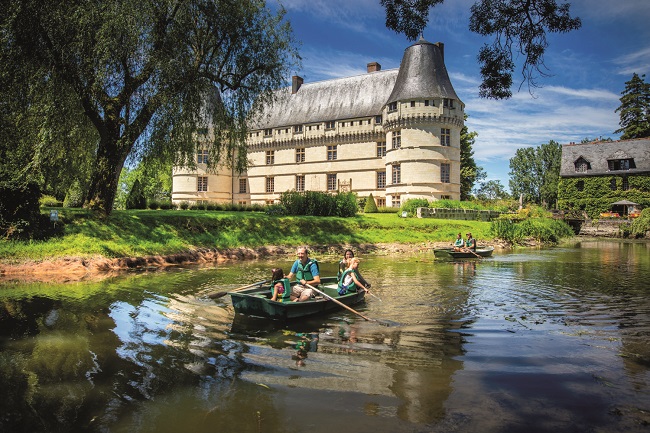
Château de L’Islette © David Darrault
Château de Guédelon, Yonne
This château is entirely different from all the others featured here in that it hasn’t actually been built yet. Deep in a Burgundy forest, just over 100 miles south of Paris, it’s an architectural and archaeological experiment where all the builders are constructing a genuine 13th-century castle using only medieval tools and methods. No modern cranes or lorries or electric tools on this building site. As far as possible, all the craftsmen and women here both work and dress exactly as their ancestors would have 800 years ago. Wearing woollen smocks, there are quarrymen hewing rocks out of the ground; stonemasons tapping away with their chisels; carpenters hand-sawing trees cut from the local forest by lumberjacks; blacksmiths forging the iron tools; tilers digging clay from the ground nearby and firing it in ovens; and carthorses transporting all these materials around the site. The whole project aims to rediscover the secrets of medieval architecture and to teach modern builders how to work with traditional tools and materials. Visitors are encouraged to engage with the builders while they toil away, rather like an interactive theme park.
Construction on Guédelon started in 1998 and isn’t due to finish until 2030 at the earliest. This year it’s open to time-travelling visitors from April 1 to November 5.
www.guedelon.fr
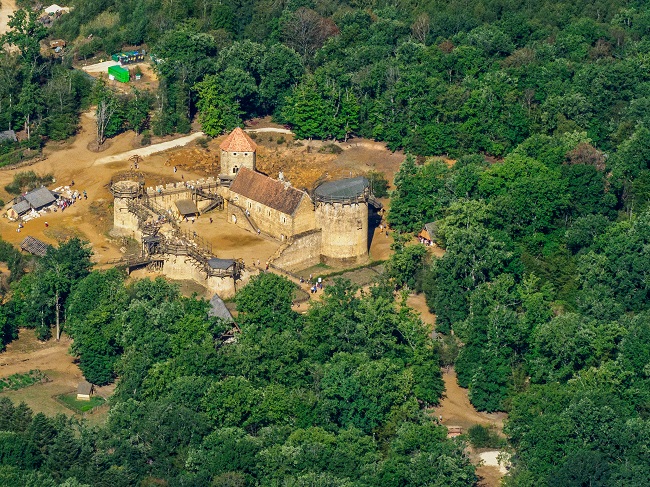
Guédelon castle © Francois Boizot / shutterstock
Glorious châteaux gardens
In some châteaux the gardens can be just as impressive, if not more impressive, than the building itself. Manicured flowerbeds, tree-lined walkways, moats and garden festivals… you can enjoy all these and more.
Château du Clos Lucé, Indre-et-Loire
In the early 1500s, a certain Leonardo da Vinci spent three years living in this Loire Valley château. At one point his most famous painting, the Mona Lisa, was stored here and it was here, in May 1519, that the great man died, in the arms of King Francis I, or so the story goes. Nowadays the château rooms have been turned into a museum dedicated to the legendary genius. Outside in the château grounds are interactive displays of some of his greatest engineering inventions. “As you walk, you meet Leonardo the engineer, Leonardo the visionary and Leonardo the painter and architect,” a château spokesperson explains. “In the park, climb aboard the assault chariot, action the aerial screw, manipulate the multi-barrelled gun, sail on the paddle boat and walk on the revolving bridge and the 20m-high double-span bridge, all crafted the original way.” It’s fascinating stuff.
vinci-closluce.com
Various châteaux in Val d’Oise
The Val d’Oise department, just north of Paris, has some of France’s most stunning châteaux. These include the Château de La Roche-Guyon, uniquely set into the chalk cliffs behind it and featuring a medieval dungeon; the Domaine de Villarceaux, an 80-hectare property in Chaussy (free entry, open Tuesday to Sunday); the Château d’Auvers, with its stunning Impressionist paintings (open Tuesday to Sunday, €12); Château d’Ambleville, built in the Renaissance style with Italian-style gardens (open summer only); and Château d’Écouen, with its Renaissance museum (open Tuesday to Sunday, €5).

Le Clos Lucé © Video Media Studio Europe / shutterstock
Château d’Ussé, Indre-et-Loire
Shielded from the outside world by the thick Chinon forest, the Château d’Ussé was the inspiration for the Charles Perrault fairy tale Sleeping Beauty. And when you view its Gothic turrets, soaring chimneys, grand staircases and sumptuous interiors, you quickly realise why. The pièce de résistance, however, is the terraced garden designed by André Le Nôtre, the brains behind Palace of Versailles’ landscaping. Le Nôtre aimed to bowl over visitors by playing around with symmetry, geometrical shapes and perspective, and by adorning his gardens with fountains, ornamental lakes, fruit trees, flower beds and cedars. The results are stunning. Just be sure to remember what happened to Sleeping Beauty, though: don’t prick your finger.
The château is open from February 11 to November 5 this year. There’s also a fashion exhibition, called Telle mère, telle fille (Like mother, like daughter), which rather intriguingly explores the way in which parents control their children’s choice of clothing.
www.châteaudusse.fr
Château de Chantilly, Oise
Henri d’Orléans (1822–1897), son of Louis-Philippe, the last king of France, was a passionate collector, ensuring the Château de Chantilly became a stunning showcase for his countless masterpieces and precious manuscripts. In 1886 he gifted the château to the Institut de France and nowadays this fabulous site – just 40km north of Paris – includes the Condé Museum and is open to the public every day except for Tuesdays. Tickets cost €9 for the grounds alone, and €17 for the château and grounds combined.
chateaudechantilly.fr
Château de Villandry, Indre-et-Loire
Above all else, the Château de Villandry is famed for its gardens, a meticulous network of tidy box hedges, fragrant herbs and vibrant flowers. Smartly planted, they offer a multi-coloured feast, whatever the time of year, thanks to their seasonal plants and vegetables: in autumn, you can soak up the hues of orange, red and purple, while in high summer you’ll experience dazzling greens and hot pinks. The interior is also a sight for sore eyes, with gorgeous Renaissance décor and rooms laid out in splendid 16th century-style. The gardens are open every day of the year, even Christmas Day, while the château itself is open from February 4 to November 12, and December 2 to January 7.
www.chateauvillandry.fr/en
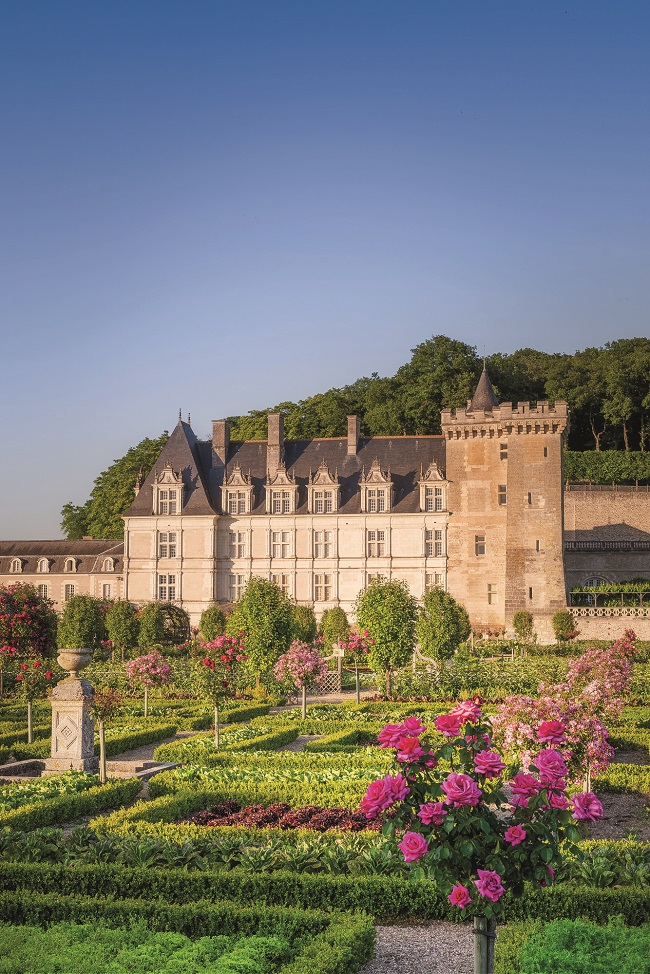
Château de Villandry © Jean-Christophe Coutand
Château de Hautefort, Dordogne
The interior of this neoclassical château in the Périgord is impressive enough. The exterior, though, will take your breath away. First up is the three-hectare French garden, with its parterres, consisting of geometrical boxwood hedges, bright flowerbeds and yew topiary. Beyond this are the organic vegetable garden and a 30-hectare English-style park with a network of woodland paths and some remarkable tree species. The château is open every day from April to November.
www.chateau-hautefort.com
Château de Chenonceau, Indre-et-Loire
Looking like it’s almost floating above the River Cher, this château, with its stylised moat, turrets, towers and drawbridge, is a veritable beauty. However, it’s the 70 hectares of landscaped gardens and lush forest rather than the tourist-heavy interiors that are most interesting. On either side of the river you can visit the gardens of Diane de Poitiers, Catherine de’ Medici, the Jardin Vert, the yew maze, or the vast flower garden.
Both the château and the gardens are open every day of the year (even Christmas) which, as everyone knows, is a rarity in France.
www.chenonceau.com
Château de Versailles, Yvelines
Undoubtedly the most famous château in France (possibly even on the planet), Versailles served as the political capital and seat of the royal court from 1682 until revolutionaries dragged off Louis XVI and Marie Antoinette to face the guillotine. To avoid getting overwhelmed by a sea of other tourists, head for the wonderful 800-hectare Parc de Versailles where you can enjoy vast, manicured, formal gardens populated by endless statues and water features, the English-style Jardins du Petit Trianon, the Orangery, the Grand Canal where rowing boats are available to hire, and the Lake of the Swiss Guard. Without a doubt, you will be amazed.
www.chateauversailles.fr
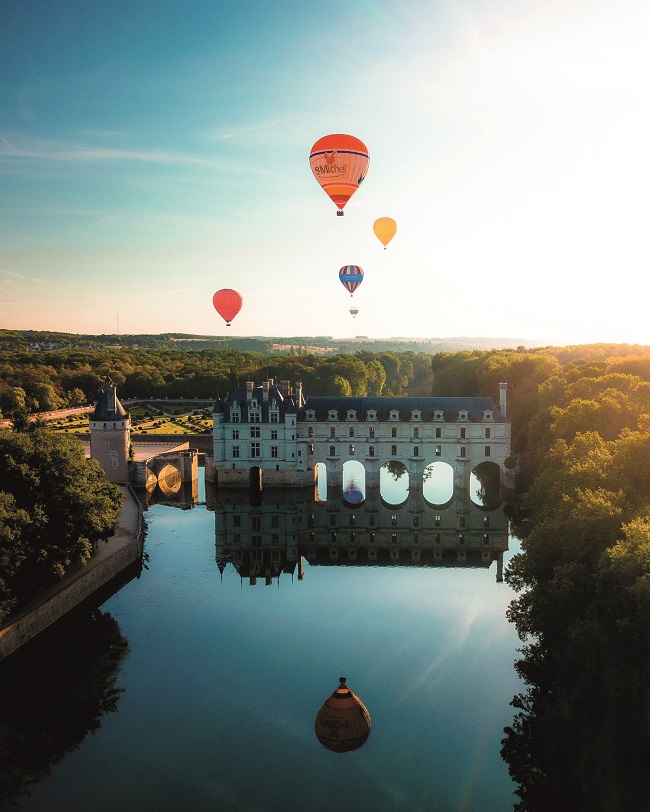
Château de Chenonceau © Paul Rivas
Maison du Berneuilh, Gironde
This 80-hectare family estate is just half an hour south of Bordeaux within the Entre-deux-Mers vineyard region. “The wines from these sunny plateaus have always been sought after for their exceptional quality,” say the owners. “It is one of the rare cellars to have so many vintages.” The family prefers to “vinify in the old way”, allowing the lees to rest for at least five years. Also available are lovely local walks, workshops, tastings (of course) and cellar visits.
www.facebook.com/chateauduberneuilh
Vignobles Jade, Gironde
Right among the vineyards of Saint-Émilion, Château Fleur de Lisse is a family estate where the owner, Caroline Teycheney, offers tastings, workshops and other events at her Vignobles Jade. The tours range from a basic wine tasting lasting 45 minutes (for €7 per person) to the Jade Experience, which includes a two-hour visit to the vineyard, cellars and ageing room (for €50 per person). There’s also an excellent wine bar.
en.vignoblesjade.com
Lead photo credit : Château d'Ussé © Renaud Whoisreno Loeuillet
Share to: Facebook Twitter LinkedIn Email
More in chateau gardens, chateaux in France, French castles, French gardens, most beautiful castles in France
Leave a reply
Your email address will not be published. Required fields are marked *




REPLY